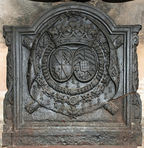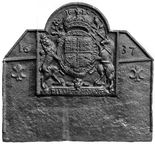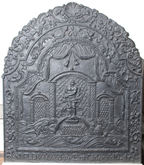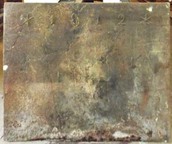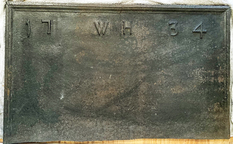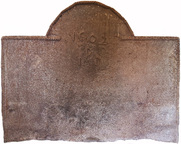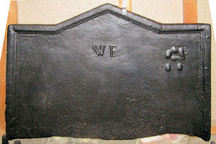-
957
Description: Upon a rectangular base plinth, an arched rectangular, ovolo-moulded panel containing a draped cloth (disclosing on the reverse the arms of Duras) upon which two oval shields are surmounted by a ducal coronet, and encircled by the collars of the Orders of St Michel and Saint-Esprit. Behind the cloth are crossed batons of a Marshal of France; on each side are flattened S-scrolls with tassels.
Notes: In all probability the arms of Jean-Baptiste de Durfort, Duc de Duras (1684-1770), created Marshal of France in 1741.
Arms: Durfort, duc de Duras
- Decoration tags:
- rectangular with round arch (shape)
- ovolo (edging)
- whole carved pattern
- armorial
Manufactured: in the early- to mid-18th century in France.
Current location: Chateau de Duras, Duras, Lot-et-Garonne, France.
- Attached to series:
- Foreign armorial firebacks
-
955
Description: Composite; canted arched rectangular shape; armorial fireback, cavetto edging, with Stuart Royal arms, garter, supporters, crown and motto, and 1620 date above crown; this overlies a canted rectangular plate, with twisted rope edging, fillet; two quasi-horizontal fillets from the tops of the vertical sides to the middle of the armorial fireback separate the back into two uneven parts, the date in the top part, split by the armorial, and a fleur-de-lys at the top of the lower part, also separated by the armorial.
Notes: The use of the armorial back is seen frequently and probably dates from 1619, though the date is usually altered; in this case the alteration does not match the more prominent date for the fireback; photograph ex T. Crowther & Son Ltd, 1985.
Inscription: 16 29 / HONI SOIT QUI MAL Y PENSE / 16 37 / DIEV ET MON DROIT
Arms: English Stuart royal
- Decoration tags:
- rectangular with canted top corners and round arch (shape)
- rope (edging)
- carved stamps
- whole carved pattern
- composite
- individual numbers
- heraldic
- armorial
- royal
- text
Manufactured: in 1637 possibly in the Forest of Dean area of England.
Current location: not known.
-
271
Description: Arched rectangular shaped central panel with top corners cavetto canted, bead-and-pellet edging on a wide fillet; hanging drapery with central tassels over three low-arched cubicles, the two outer smaller than the centre, with Tuscan columns and overlapping scales behind; on a plinth of overlapping scales with a scallop shell behind, the standing figure of Neptune/Poseidon, holding a trident in his right hand; water issues from by his feet and from the waves below him disport two ‘sea horses’ and three dolphins; arched rectangular shaped border with top corners cavetto canted, fillet edging: suspended symmetrical beads with tassel ends decorated with sea shells; between two looped 'W' figures, the inscription separating halves of the date along the bottom; above, a central scallop shell with symmetrical floral scrolls on each side.
Notes: From a design in 'Nouveaux livres de ...Statues [etc.]' (La Haye & Amsterdam 1702-5), by Daniel Marot. The inscription, translated as 'GOD is our strength', is a paraphrase of Psalm 46: 1; the original wooden pattern is in Museum Rotterdam (no. 931}; an identical inscription and date is found on several firebacks. All incorporate the looped 'W' motif which may be intended to identify the pattern maker. Formerly at Dogwells Farmhouse, Corscombe, Dorset; other examples are at Leith Hill Place, Surrey, and Lower Brockhampton farmhouse, Herefordshire, the latter having originally been in Dunster Castle, Somerset.
Copies of this fireback are known.
Inscription: 17 DVW Ydyw Ein Cadernid 24
- Decoration tags:
- 'Dutch' (shape)
- fillet (edging)
- whole carved pattern
- pictorial
- mythological
- architectural
- text
- animals
- humans
- objects
Manufactured: in 1724 in England.
Current location: Dorset County Museum, Dorchester, Dorset, England.
(part of the Dorset County Museum museum group)
- Attached to series:
- 1724 series
- Welsh inscription series
- British 'Dutch' style firebacks
-
941
Description: Arched rectangular shape; scalloping within wide fillet edging; shield, knight's helm, crest and mantling; date split either side of armorial.
Notes: The arms are of Kyrle (vert, a chevron between three fleurs de lys or; crest: on a mount vert a hedgehog or) of Much Marcle, Herefordshire, quartered with Abrahall (azure three hedgehogs or; the fess appears to be erroneous) and Warnecombe (sable, on a fess dancetty argent between three bezants each charged with an escallop of the field as many lions rampant argent armed and langued gules). The second part of the date appears to have been altered by hand for the present casting as the style of lettering for the final two numerals is crude compared with the first two. Sir John Kyrle may have operated the iron furnace at Whitchurch, between Monmouth and Ross on Wye; the style of the carving is the same as on two other firebacks in the same county. It is apparent, from another example, that this fireback has either been broken and repaired, or deliberately reduced in height. Originally the mantling of the helm extended further down, ending in tassels on each side, making the height of the fireback approximately equal to its width. An early photograph of the Fawley fireback, taken by Alfred Watkins, the Herefordshire antiquarian, shows the division of the two parts more clearly (Herefordshire Record Office, AW339b). A copy of the original, un-reduced fireback has been noted with the date 1685 in the distinctive numerals seen on firebacks from Flaxley Furnace, Gloucestershire.
Copies of this fireback are known.
Inscription: 16 20
Arms: Kyrle quartering Abrahall and Warnecombe
- Decoration tags:
- rectangular with round arch (shape)
- fillet with scalloping (edging)
- whole carved pattern
- individual numbers
- armorial
- text
Manufactured: in 1620 possibly at Whitchurch Furnace in the Herefordshire area of England.
Current location: in private hands, Fawley, Herefordshire, England.
- Attached to series:
- Personal armorial firebacks
- Herefordshire armorial series
-
112
Description: Rectangular with twisted rope edging; straight lengths of rope re-stamped to make longer lengths in the shape of a saltire on each side and a 'V' in the middle.
Notes: The arrangement of the rope lengths may have an apotropaic significance, a double 'v' alluding to the Virgin Mary. Formerly part of the Ade Collection (from Grove Hill, Hellingly, Sussex).
- Decoration tags:
- rectangular (shape)
- rope (edging)
- simple stamps
- apotropaic
- objects
Manufactured: in the mid- to late-16th century in the Weald area of England.
Current location: Hastings Museum and Art Gallery, John's Place, Bohemia Road, Hastings, East Sussex, England.
Museum number: HASMG: 1952.51.20 (part of the Hastings Museum museum group)
- Attached to series:
- Rope design firebacks
-
1127
Description: Plain rectangle; no edging; top centre, date between two six-pointed stars.
Notes: Characteristic of the last firebacks cast at Ashburnham Furnace, Sussex. One of a small series of firebacks cast in the early-19th century for farms on the Ashburnham estate.
Inscription: * 1812 *
- Decoration tags:
- rectangular (shape)
- none (edging)
- carved stamps
- individual numbers
- text
- objects
Manufactured: in 1812 at Ashburnham Furnace in the Weald area of England.
Current location: not known.
- Attached to series:
- Date only firebacks
- Ashburnham late series
-
1236
Description: Rectangular; ogee moulding on top and side edges; symmetrical layout of date and initials; date split between left and right sides, initials in middle.
Notes: One of a series of backs dating to the 1730s and 40s using very similar sets of letters and numerals. Formerly at Yeomans, Mayfield, Sussex.
Inscription: 17 / WH / 34
- Decoration tags:
- rectangular (shape)
- cyma reversa/ogee (edging)
- carved stamps
- individual letters
- individual numbers
- text
Manufactured: in 1734 in the Weald area of England.
Current location: not known.
- Attached to series:
- 1730s-40s, date & initial series
-
959
Description: Arched shape; twisted rope edging (top and sides); top centre, shield of impaled arms; date above shield; initials, in triad ('F above), to right of shield.
Notes: The arms are of Sir Peter Frecheville (1575-1634) of Staveley Hall, Derbyshire, and his first wife, Joyce Osborne, née Fleetwood (d.1619), whom he had married in the year of the fireback's casting; the blazon is as follows: (Frecheville) Azure, a bend between six escallops argent; (Fleetwood) Per pale nebuly or and azure, six martlets, two, two and two counterchanged (the tinctures, as painted, are incorrect). At the bottom of the fireback there appears to be the remains of a runner by which the molten iron flowed into the sand mould.
Inscription: 1605 / PFI [triad]
Arms: Frecheville impaling Fleetwood
- Decoration tags:
- rounded arched (shape)
- rope (edging)
- whole carved pattern
- individual letters
- individual numbers
- armorial
- text
Manufactured: in 1605 probably at Staveley Furnace in the Derbyshire area of England.
Current location: Staveley Hall, Staveley Hall Drive, Staveley, Derbyshire, England.
- Attached to series:
- Personal armorial firebacks
-
1254
Description: Arched rectangular shape; twisted rope edging (top, and sides short of bottom), with shoulder edging extending into base of arch; upper centre, date '1602' slanting down to right; below date, initials 'IPD' in triad.
Notes: The initials are likely to be those of a couple whose surname begins with 'P'.
Inscription: 1602 / I P D [triad]
- Decoration tags:
- rectangular with round arch (shape)
- rope (edging)
- carved stamps
- individual letters
- individual numbers
- text
Manufactured: in 1602 possibly in the Weald area of England.
Current location: not known.
- Attached to series:
- Date & initials firebacks
-
715
Description: Rectangular with pediment arch; wide fillet edging rebated in side edge; upper centre, initials formed of individual letters; an unidentified series of shapes in relief in the top right corner may be thumb prints.
Notes: The edging and letter ‘W’ are very similar to those on the ‘1589’ series of firebacks and may have the same origin. Formerly at Bay Hall, Benington, Lincolnshire.
Inscription: WE
- Decoration tags:
- rectangular with triangular arch (shape)
- rebated fillet (edging)
- carved stamps
- individual letters
- text
Manufactured: in the late-16th century possibly in the Weald area of England.
Current location: not known.
- Attached to series:
- Initials only firebacks
